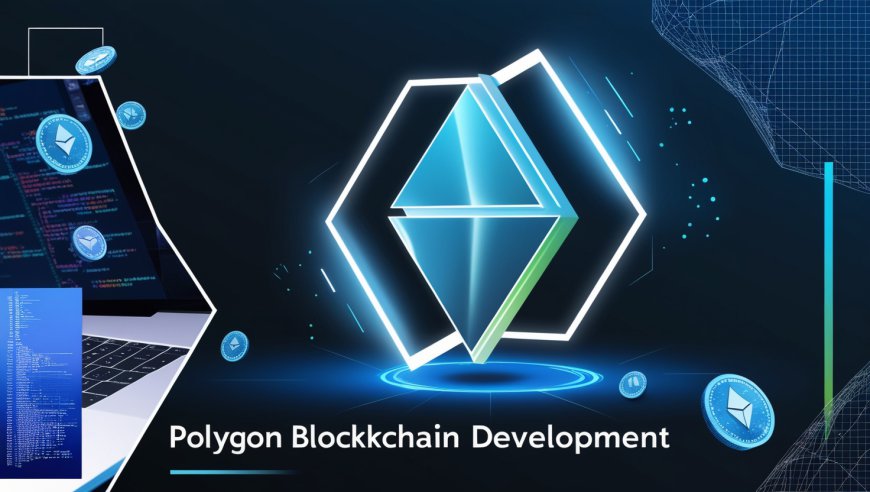Polygon Blockchain Development: Powering the Future of Decentralized Solutions

The blockchain ecosystem is evolving rapidly, and while Ethereum remains a dominant force, its challenges in scalability and transaction costs have prompted the rise of alternative solutions. One of the most innovative among them is Polygon. Formerly known as Matic Network, Polygon is a Layer 2 scaling solution designed to enhance Ethereum's scalability, offering developers a framework to build decentralized applications (dApps) with enhanced performance and lower costs. Let’s dive into the world of Polygon blockchain development and understand how it is shaping the future of decentralized solutions.
Understanding Polygon: A Layer 2 Solution for Ethereum
Polygon was built to address the shortcomings of Ethereum, especially in terms of scalability and usability. The Ethereum network, while powerful, often experiences high gas fees and slow transaction speeds due to congestion. This can hinder user experience and deter developers from building complex applications.
Polygon is a Layer 2 scaling platform that connects Ethereum-compatible blockchain networks. It improves Ethereum's functionality by enabling faster, more affordable transactions without compromising on security. This is achieved through various features such as Plasma chains, ZK-Rollups, and Optimistic Rollups, all aimed at offloading some of Ethereum's transaction load and offering efficient alternatives.
Key Features of Polygon
1. High Scalability
Polygon's architecture is designed to enhance scalability, offering developers a flexible framework to build scalable dApps. The platform's Proof-of-Stake (PoS) consensus mechanism allows for faster block times and low transaction costs. This makes it suitable for large-scale decentralized applications such as DeFi platform and NFT marketplaces.
2. Interoperability
One of Polygon's strongest features is its interoperability with Ethereum. Polygon is fully compatible with Ethereum's Virtual Machine (EVM), allowing developers to easily port their Ethereum-based dApps onto the Polygon network without the need to rebuild from scratch. This also ensures that existing Ethereum dApps can benefit from the improved performance offered by Polygon.
3. Security
Polygon relies on Ethereum’s robust security architecture. By leveraging Ethereum’s base layer, Polygon ensures that applications deployed on its network maintain the highest level of security through the use of its PoS mechanism and Plasma chains. These mechanisms prevent malicious activity and protect the network from attacks.
4. Low Transaction Costs
For developers and users alike, transaction fees are a critical factor in the usability of a blockchain platform. On Ethereum, gas fees often spike during network congestion, making transactions costly. Polygon addresses this by offering significantly lower transaction fees, which allows developers to build more complex applications without worrying about prohibitive costs.
Benefits of Polygon Blockchain Development
1. Enhanced User Experience
For both developers and end-users, the improved speed and affordability of transactions on Polygon make for a smoother experience. Applications such as games, NFTs, and defi staking platform development can perform seamlessly without the latency and cost issues common on Ethereum.
2. Ecosystem Growth
Polygon has quickly grown into one of the largest ecosystems in the blockchain space. Developers from all around the world are leveraging its features to build innovative applications. This includes well-known projects like Aave, Sushiswap, and OpenSea that have migrated or integrated with the Polygon network to take advantage of its scalability.
3. Developer-Friendly Tools
Polygon offers a variety of developer tools and SDKs that simplify the process of building dApps. These tools are designed to ensure that developers can quickly create and launch their applications without navigating the complexities of Ethereum’s infrastructure. Moreover, Polygon’s extensive documentation and community support foster innovation by providing developers with the resources they need to succeed.
4. Decentralized Finance (DeFi) Opportunities
Polygon has become a hub for DeFi projects, offering a range of decentralized financial services like lending, borrowing, and trading with minimal transaction costs. The growth of the DeFi sector on Polygon has attracted major players and continues to stimulate innovation in the space.
Use Cases of Polygon Blockchain
-
DeFi Applications: DeFi protocols such as QuickSwap and Aave have integrated with Polygon to offer users cheaper and faster transactions while maintaining the decentralized nature of their services.
-
Gaming: Blockchain-based games like Zed Run use Polygon to provide players with an uninterrupted experience by reducing latency and gas fees.
-
NFT Marketplaces: With the rising popularity of NFTs, platforms like OpenSea have migrated to Polygon to offer users a more cost-effective way to trade and mint NFTs.
-
Supply Chain Solutions: Polygon is being explored as a solution for building decentralized supply chain applications, offering transparency, immutability, and enhanced efficiency in tracking goods and services.
Conclusion
Polygon blockchain development is a significant step forward in overcoming the challenges of Ethereum’s scalability and high gas fees. By providing developers with a flexible and secure platform to build decentralized applications, Polygon is shaping the future of blockchain. Its scalability, low transaction fees, and interoperability with Ethereum have led to its rapid adoption across industries, making it a critical player in the blockchain space. Whether you’re developing DeFi solutions, NFTs, or enterprise applications, Polygon offers the infrastructure needed to build next-generation decentralized applications.
